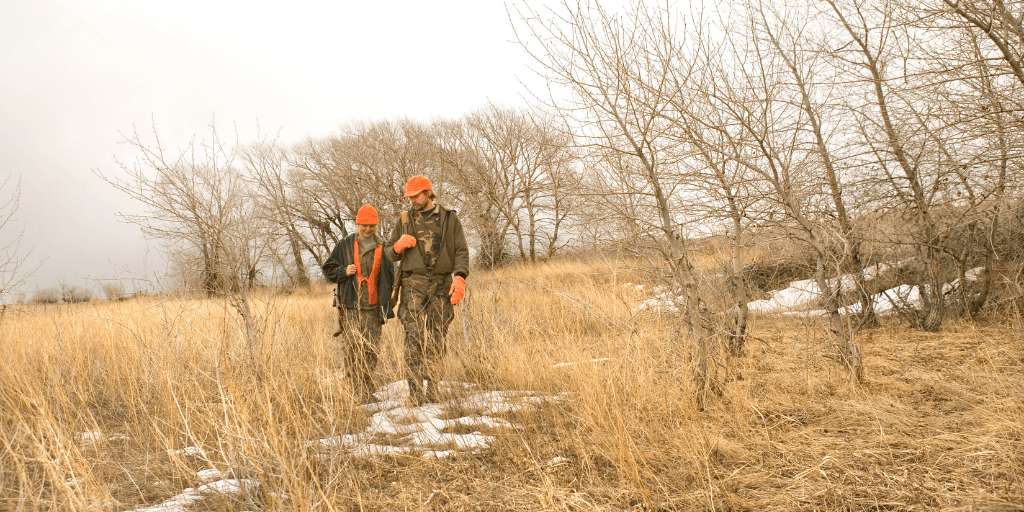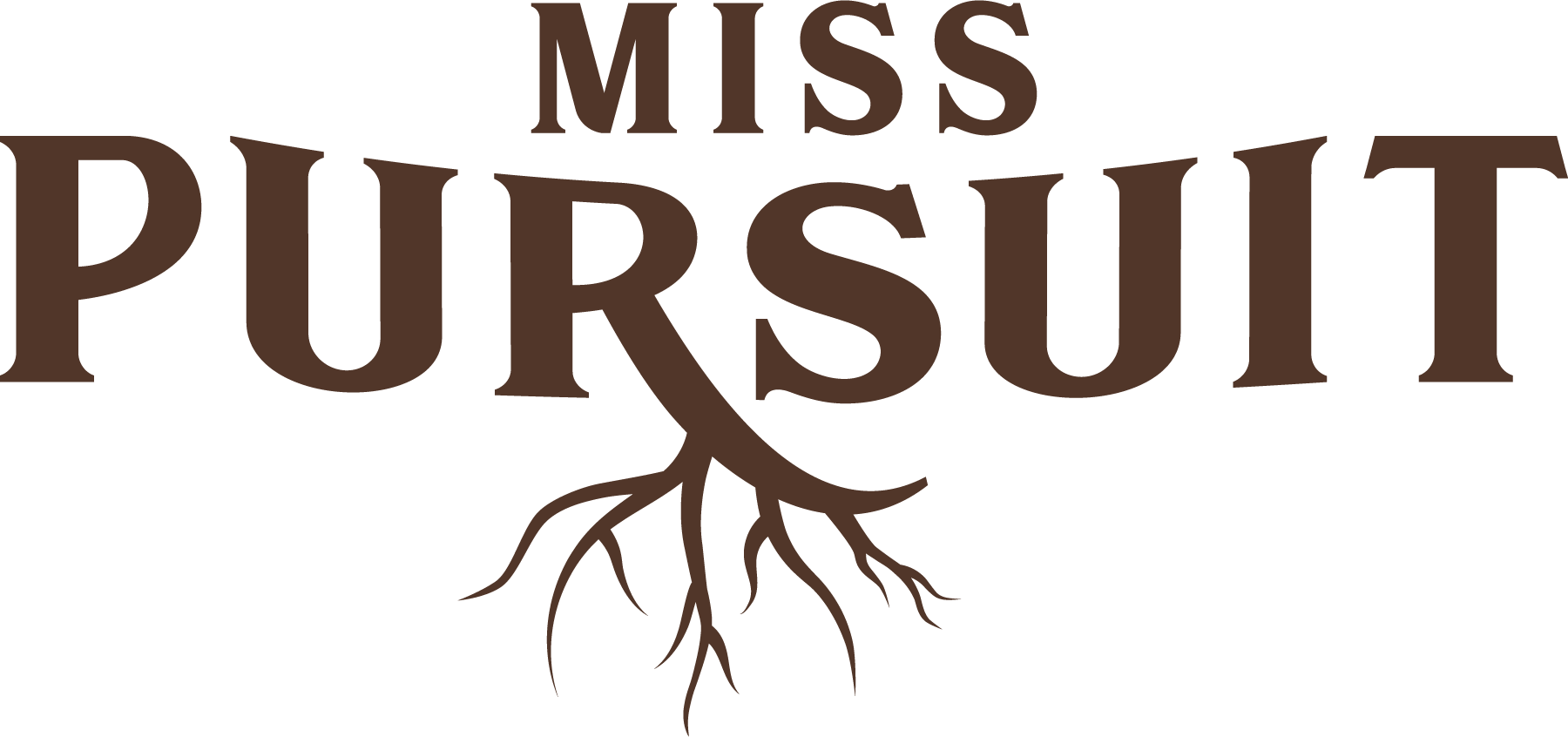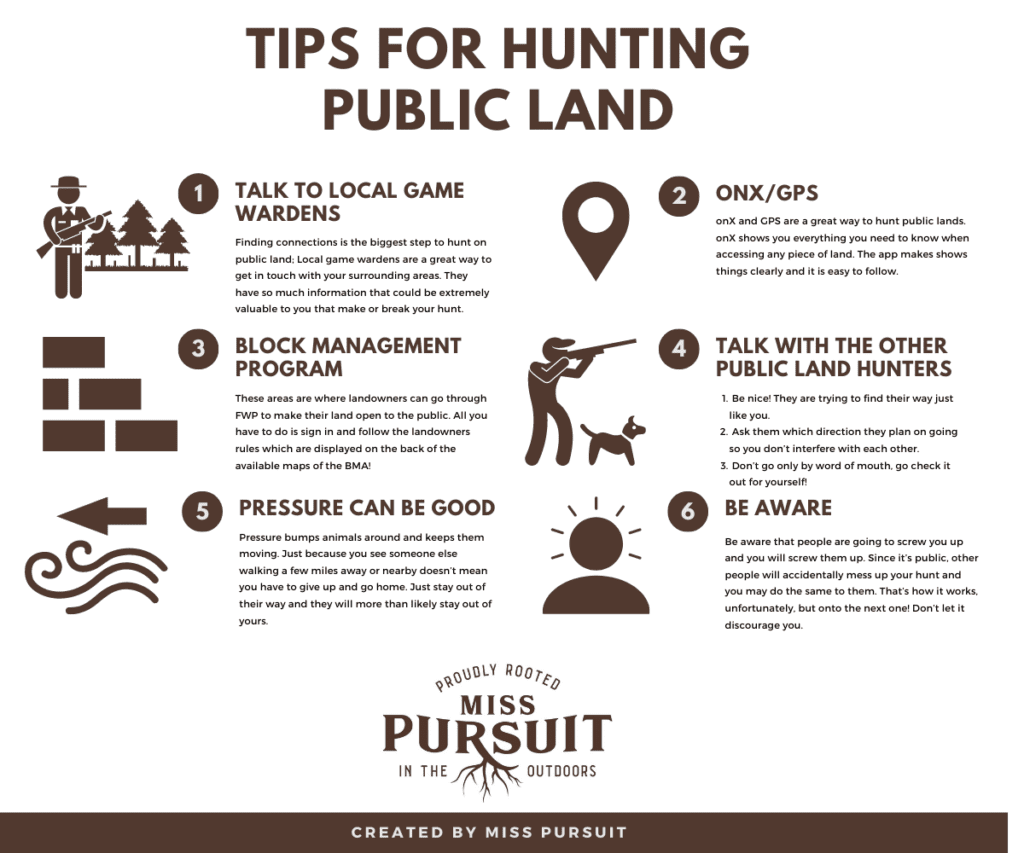Hunting on public land can be challenging, but with these 15 essential tips, you'll be able to navigate the terrain like a pro and increase your chances of success.
Tips for Hunting Public Land:
Talk to local game wardens.
Finding connections is the biggest step to hunt on public land; I'm certainly not the only one who finds it beneficial. Connections are an easy way to find out where to hunt, the boundaries, the animals in the area, and how to hunt them. Local game wardens are a great way to get in touch with your surrounding areas. They have so much information that could be extremely valuable to you that make or break your hunt.

Use onX/GPS.
onX and GPS are great ways to hunt public lands. onX shows you everything you need to know when accessing any piece of land. The app makes shows things clearly and it is easy to follow. It’s easy to save maps for when you are out of service so you never lose access to them. As a public land hunter, onX has been a lifesaver!
Look into a Block Management Program.
Here in Montana, we have an awesome program called a BMA (Block Management Area). These areas are where landowners can go through FWP to make their land open to the public. All you have to do is sign in and follow the landowner's rules which are displayed on the back of the available maps of the BMA!
Talk with the other public land hunters.
- Be nice! They are trying to find their way just like you.
- Ask them which direction they plan on going so you don’t interfere with each other.
- Don’t go only by word of mouth, go check it out for yourself!
{New to hunting? Check out these tips for new hunters!}
Pressure can be good.
Pressure bumps animals around and keeps them moving. Just because you see someone else walking a few miles away or nearby doesn’t mean you have to give up and go home. Just stay out of their way and they will more than likely stay out of yours.
Be aware that people are going to screw you up and you will screw them up.
Since it's public, other people will accidentally mess up your hunt and you may do the same to them. That’s how it works, unfortunately, but onto the next one! Don’t let it discourage you.
Unveil hidden treasures by scouting.
Before embarking on your hunting expedition on public land, it's crucial to scout the area thoroughly. This preparatory step allows you to uncover hidden gems, identify potential hunting spots, and familiarize yourself with the land. As an avid hunter myself, I can attest to the importance of this initial groundwork.
When scouting, keep your senses sharp and be on the lookout for animal signs. Tracks, droppings, and other indicators can guide you toward areas frequented by your desired game. Pay attention to the terrain and vegetation, as they provide valuable insights into animal behavior and preferred habitats. By studying the land beforehand, you gain a strategic advantage, increasing your chances of a successful hunt.
Follow local regulations.
In the world of hunting on public land, it's essential to respect and abide by the rules and regulations specific to each area. Local authorities establish these guidelines to maintain balance and ensure the sustainability of wildlife populations.
Before setting foot on public land, take the time to thoroughly research and understand the regulations governing the area. Hunting seasons, bag limits, weapon restrictions, and designated hunting zones can vary from one location to another. By familiarizing yourself with these rules, you avoid potential legal issues and contribute to the preservation of natural resources.
Protect yourself and others.
Hunting on public land involves sharing the territory with fellow enthusiasts like yourself. To ensure a safe and enjoyable experience for everyone, it's crucial to prioritize safety measures.
First and foremost, make yourself visible to others. Wearing bright orange clothing significantly increases your visibility and reduces the risk of accidents. Additionally, it's vital to practice proper firearm handling techniques at all times – at. all. times. Treat every firearm as if it were loaded, keep your finger off the trigger until you're ready to shoot, and be aware of your target and what's beyond it.
Maintaining awareness of other hunters' locations is essential to prevent mishaps. Before firing a shot, always ensure that your shooting lane is clear of other individuals. Communicate with fellow hunters, establish clear boundaries, and respect each other's space.
Decode nature's clues.
When venturing into the realm of hunting public land, honing your tracking skills and understanding animal behavior becomes paramount. Tracking is an art that allows us to read the stories written on the ground, deciphering the secrets left behind by our quarry.
Animal tracks are the breadcrumbs of the wild, revealing the presence and movements of our target species. Learning to identify and interpret these tracks can lead us to prime hunting spots. By understanding behavior patterns, such as feeding or bedding areas, we gain insight into where and when to focus our efforts.
But tracking is not limited to footprints alone. Utilizing camouflage and scent control methods further enhances our stealth and increases the likelihood of a successful hunt. Blending into the surroundings and minimizing our human scent can fool even the most wary of game.
Equip yourself for success.
Preparing for a hunt on public land necessitates careful consideration of the gear we carry. Each piece serves a purpose, contributing to our overall effectiveness and comfort in the field.
When it comes to firearms or bows, selecting the right tool for the job is essential. Consider the characteristics of your target species, the terrain you'll be navigating, and any legal restrictions that may apply. It's crucial to strike a balance between power, accuracy, and maneuverability.
Clothing layers tailored to varying weather conditions are crucial for comfort and adaptability. From base layers that wick away moisture to insulating mid-layers and weatherproof outer shells, our attire should withstand the elements and allow us to regulate our body temperature effectively.
Footwear, too, plays a vital role. The terrain on public land can be diverse and challenging, from rugged mountains to wet marshes. Selecting appropriate boots that offer comfort, support, and traction on different surfaces ensures we can cover ground with confidence.
Additional equipment like binoculars, range finders, and calls can significantly aid our hunting efforts. Binoculars enable us to spot game from a distance, while range finders assist in accurately judging distances for precise shots. Calls can mimic the sounds of animals, attracting them within our range.
Adapt to the landscape and species.
Public land presents us with a diverse array of landscapes, each harboring unique characteristics and wildlife. To maximize our chances of success, we must employ suitable hunting strategies tailored to the environment and target species.
Spot-and-stalk is a versatile technique, well-suited for open terrain. It involves spotting game from a distance and then stealthily closing the gap, using the available cover to remain undetected. This approach demands patience, skill, and a keen eye for detail.
Tree stand hunting provides an elevated vantage point, granting us a broader perspective and minimizing our scent on the ground. Carefully selecting suitable trees and positioning ourselves in areas frequented by game can yield excellent results, particularly during periods of movement, such as dawn and dusk.
Ground blinds offer concealment and comfort, creating a sense of familiarity within the hunting environment. These portable structures can be strategically placed near trails or feeding areas, providing a hidden vantage point to observe and ambush game at close range.
Adaptability is crucial when employing hunting strategies on public land. Understanding the habits, preferences, and vulnerabilities of the target species allows us to tailor our approaches accordingly. By observing and learning from our experiences in the field, we refine our strategies and increase our chances of a successful hunt.
Nurture the land and respect the wildlife.
As a hunter who cherishes the beauty of public land, I believe in the utmost importance of conservation and ethical hunting practices. When we step foot into these natural landscapes, we become stewards of the land, entrusted with its preservation and the welfare of its inhabitants.
Responsible hunters should adhere to a set of principles that ensure the well-being of the environment. It starts with leaving no trace. We must never litter or leave behind any signs of our presence. By keeping our hunting grounds pristine, we contribute to the overall enjoyment and sustainability of the land for future generations.
Respecting wildlife habitats is crucial. Understanding the intricacies of ecosystems helps us identify areas that need protection. By avoiding disturbances to nesting grounds or crucial feeding areas, we allow wildlife to thrive undisturbed. This respect for their habitats fosters a delicate balance between our pursuit and their natural way of life.
Active participation in conservation efforts is another vital aspect of ethical hunting on public land. Supporting organizations that promote habitat restoration, species management, and scientific research ensures the longevity of our hunting opportunities. By giving back to the environment that gives us so much, we become true guardians of the land.
Adapt to nature's rhythms.
Each season brings its own set of challenges and opportunities in the realm of hunting public land. Understanding how animal behavior shifts throughout the year allows us to fine-tune our strategies and increase our chances of success.
During the rut, or mating season, animals like deer and elk undergo significant behavioral changes. Bucks and bulls become more active, searching for mates and defending their territories. By studying their rutting patterns and vocalizations, we can position ourselves in prime locations to intercept them during this heightened period of activity.
By observing tracks and other signs near water holes or rivers, we can predict animal movement patterns and focus our efforts accordingly.
Adapting to winter conditions requires additional preparation. Animals seek shelter, concentrate in lower elevations, and become more reliant on food sources. Identifying their wintering areas, such as dense vegetation or areas with ample forage, provides valuable insights for locating game during this challenging time of year.
Prepare for the unforeseen.
When venturing into remote public land areas, it's crucial to equip ourselves not only with hunting gear but also with essential first aid knowledge and survival skills. Nature is unpredictable, and unforeseen circumstances can arise, making these skills invaluable.
Basic wound care is essential. Knowing how to clean and dress a wound can prevent infections and promote healing. Carrying a well-stocked first aid kit ensures that we can address injuries promptly, mitigating potential complications.
Navigation techniques are vital when traversing vast and unfamiliar terrains. Understanding how to use a map and compass, or even a GPS device, allows us to navigate with confidence and avoid getting disoriented. These skills become even more critical when visibility is limited or when exploring off-trail areas.
In emergency situations, knowing how to signal for help can be a lifesaver. Carrying signaling devices like whistles or mirrors can attract attention and aid in rescue efforts. Additionally, learning basic survival skills, such as building a shelter or starting a fire, prepares us for unexpected circumstances.
As an avid hunter who appreciates the beauty of public lands, I encourage you to approach your hunting adventures with enthusiasm, respect for nature, and a commitment to safety. By following these tips and guidelines, you can embark on a memorable and rewarding journey into the heart of the wilderness. Happy hunting!
What are your best tips for hunting public land?

